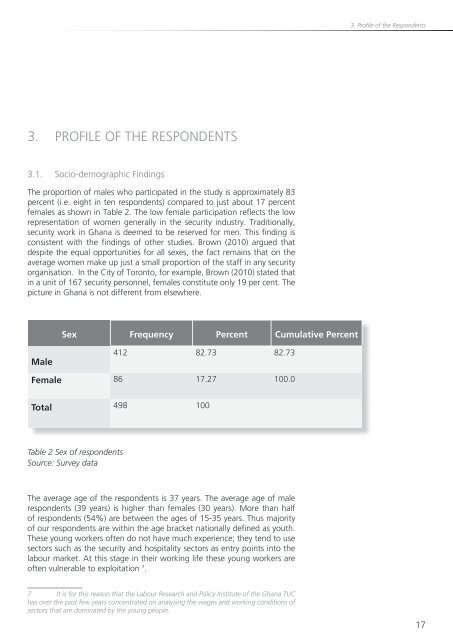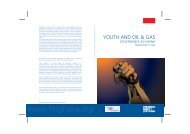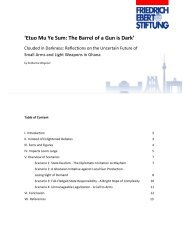Wages and Working Conditions of Private Security Workers in Ghana
Wages and Working Conditions of Private Security Workers in Ghana
Wages and Working Conditions of Private Security Workers in Ghana
You also want an ePaper? Increase the reach of your titles
YUMPU automatically turns print PDFs into web optimized ePapers that Google loves.
3. Pr<strong>of</strong>ile <strong>of</strong> the Respondents<br />
3. PROFILE OF THE RESPONDENTS<br />
3.1. Socio-demographic F<strong>in</strong>d<strong>in</strong>gs<br />
The proportion <strong>of</strong> males who participated <strong>in</strong> the study is approximately 83<br />
percent (i.e. eight <strong>in</strong> ten respondents) compared to just about 17 percent<br />
females as shown <strong>in</strong> Table 2. The low female participation reflects the low<br />
representation <strong>of</strong> women generally <strong>in</strong> the security <strong>in</strong>dustry. Traditionally,<br />
security work <strong>in</strong> <strong>Ghana</strong> is deemed to be reserved for men. This f<strong>in</strong>d<strong>in</strong>g is<br />
consistent with the f<strong>in</strong>d<strong>in</strong>gs <strong>of</strong> other studies. Brown (2010) argued that<br />
despite the equal opportunities for all sexes, the fact rema<strong>in</strong>s that on the<br />
average women make up just a small proportion <strong>of</strong> the staff <strong>in</strong> any security<br />
organisation. In the City <strong>of</strong> Toronto, for example, Brown (2010) stated that<br />
<strong>in</strong> a unit <strong>of</strong> 167 security personnel, females constitute only 19 per cent. The<br />
picture <strong>in</strong> <strong>Ghana</strong> is not different from elsewhere.<br />
Sex Frequency Percent Cumulative Percent<br />
Male<br />
412 82.73 82.73<br />
Female 86 17.27 100.0<br />
Total 498 100<br />
Table 2 Sex <strong>of</strong> respondents<br />
Source: Survey data<br />
The average age <strong>of</strong> the respondents is 37 years. The average age <strong>of</strong> male<br />
respondents (39 years) is higher than females (30 years). More than half<br />
<strong>of</strong> respondents (54%) are between the ages <strong>of</strong> 15-35 years. Thus majority<br />
<strong>of</strong> our respondents are with<strong>in</strong> the age bracket nationally def<strong>in</strong>ed as youth.<br />
These young workers <strong>of</strong>ten do not have much experience; they tend to use<br />
sectors such as the security <strong>and</strong> hospitality sectors as entry po<strong>in</strong>ts <strong>in</strong>to the<br />
labour market. At this stage <strong>in</strong> their work<strong>in</strong>g life these young workers are<br />
<strong>of</strong>ten vulnerable to exploitation 7 .<br />
7 It is for this reason that the Labour Research <strong>and</strong> Policy Institute <strong>of</strong> the <strong>Ghana</strong> TUC<br />
has over the past few years concentrated on analys<strong>in</strong>g the wages <strong>and</strong> work<strong>in</strong>g conditions <strong>of</strong><br />
sectors that are dom<strong>in</strong>ated by the young people.<br />
17









